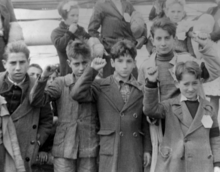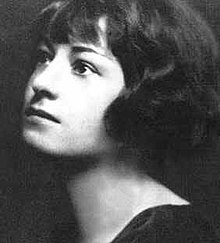Joint Anti-Fascist Refugee Committee
 Children preparing for evacuation, some giving Spanish Republican salute (raised fist) | |
| Formation | 1941 |
|---|---|
| Founder | Edward K. Barsky |
| Founded at | New York City |
| Dissolved | 1955 |
| Merger of | North American Committee to Aid Spanish Democracy, American Medical Bureau |
| Headquarters | New York City |
| Location |
|
| Coordinates | 40°44′42″N 73°58′51″W / 40.745054°N 73.980882°W |
| Services | Humanitarian aid for Spanish Civil War refugees |
Official language | English |
National Honorary Chairman | Walter Rautensrauch |
National Chairman | Edward K. Barsky |
Secretary | Helen R. Bryan |
Treasurer | Lyman R. Bradley |
| Website | dlib |
Joint Anti-Fascist Refugee Committee (JAFRC) was a nonprofit organization to provide humanitarian aid to refugees of the Spanish Civil War.[1][2]
History

In 1941, the Joint Anti-Fascist Refugee Committee was formed by Lincoln Battalion veterans of the Spanish Civil War to provide aid to Spanish Loyalists refugees from Francoist Spain.[2] JAFRC superseded previous groups, including the North American Committee to Aid Spanish Democracy and American Medical Bureau (the latter of which Barsky had founded in 1936).[1] Specifically, JAFRC was "dedicated to the rescue and relief of thousands of anti-fascist fighters trapped in Vichy, France, and North Africa" so that they might "return to the active fight against the Axis."
JAFRC established a fundraising organization called "Spanish Refugee Appeal" of the Joint Anti-Fascist Refugee Committee."[1][3] Dorothy Parker took charge of the committee's fundraising and the anti-fascists soon attracted the support of Leonard Bernstein, Albert Einstein, Lillian Hellman, Langston Hughes, and Orson Welles.[4]
In 1942, it was licensed to do so in Vichy France by President Franklin Roosevelt's wartime administration, and the anti-fascists were then granted tax-exempt status.[5]: 70
In 1946, the JAFRC began to face nearly-constant attack from federal government organizations. In 1948, the Bureau of Internal Revenue (now the Internal Revenue Service) rescinded JAFRC's tax-exempt status. Thereafter, the Subversive Activities Control Board (SACB) tried to force JAFRC to register as a communist front organization.[1]
In April 1951, Allan Rosenberg successfully argued for the complainant Joint Anti-Fascist Refugee Committee in Anti-Fascist Committee v. McGrath before the US Supreme Court.[6]
In 1955, the JAFRC board voted to disband.[1]
People
Leaders
According to letterhead dated March 17, 1944,[7] leaders included:
- Walter Rautenstrauch, National Honorary Chairman
- Edward K. Barsky, National Chairman
- Lyman R. Bradley, National Treasurer[8]
- Helen R. Bryan, National Secretary
National Sponsors[7] included:
- Dr. Comfort A. Adams
- Rabbi Michael Aper
- Dr. Hery Lambert Bibby
- James L. Brewer
- Dr. Walter B. Cannon
- Prof. Richard T. Cox
- Martha Dodd
- Julien Duvivier
- Dr. Frederick May Eliot
- Dr. Henry Pratt Fairchild
- Lion Feuchtwanger
- Prof. Irving Fisher
- Prof. Mitchell Franklin
- Rev. Stephen H. Fritchman
- Prof. Marion Hathaway
- Kenneth Leslie
- Princess Helga zu Loewenstein
- Dr. Robert Morss Lovett
- Prof. Kirtley F. Mather
- Philip Merivale
- Rt. Rev. Edward L. Parsons
- Prof. Renato Poggioli
- Dr. Francis M. Pottenger
- Paul Robeson
- Prof. Harlow Shapley
- Dalton Trumbo
- Dame May Whitty
- Dr. Max Yergan
Members
- Moses Fishman
- Mark Straus MD[9]
- Arthur Szyk (alleged)
Spanish Refugee Appeal supporters

- Pablo Picasso, Honorary Chair
- Dorothy Parker, Chairman
National Sponsors[4][3][10] included:
- Rev. Dr. Charles B. Ackley
- Lemuel Ayers
- Aline Bernstein
- Leonard Bernstein
- Alvah Bessie
- Lyman R. Bradley
- Dorothy Brewster
- Arthur G. Brodeur
- Henrietta Buckmaster
- Rabbi Elliott Burstein
- Allan Chase
- Edward Chodorov
- John M. Coffee
- Rabbi J. X. Coeh
- Charles A. Collins
- Eugene P. Connolly
- Kyle Crichton
- Bartley C. Crum
- Bernard Davidoff
- Agness George De Mille
- Mrs. George Adams Dewey
- Earl B. Dickerson
- Dean Dixon
- Martha Dodd
- Olin Downes
- Muriel Draper
- Albert Einstein
- Rabbi Mitchel S. Eskolsky
- Philip Evergood
- Henry Pratt Fairchild
- L.S. Fanning
- Howard Fast
- Lion Feuchtwanger
- Louis Finger
- Elizabeth P. Frazier
- Rve. Stephen Fritchman
- Betty Garrett
- Frank Gervasi
- Elinor S. Gimbel
- Rabbi Solomon Goldman
- Robert Gordis
- William Gropper
- Chaim Gross
- Ralph H. Grundlach
- Richard Gump
- Ralph Gundlach
- Marion Hathaway
- Rita Hayworth
- Lillian Hellman
- Libby Holman
- Langston Hughes
- Walter Huston
- Stanley M. Isaacs
- Mrs. Sydney Joseph
- Barney Josephson
- Rober W. Kenny
- Rockwell Kent
- Fiske Kimball
- Arthur Kober
- Alfred Kreymborg
- Canada Lee
- M.V. Leof
- Kenneth Leslie
- Ray Lev
- Walter H. Leibman
- Daniel A. Longbaker
- Louis Lozowick
- Florence J. Luscomb
- Richard Lyndon
- Louis F. McCabe
- John T. McManus
- Rev. Dr. John D. Mackay
- Manuel Magana
- Albert Maltz
- Alfred T. Manacher
- Richard Maney
- Heinrich Mann
- Thomas Mann
- Alicia Markova
- George Marshall
- Kirtley F. Mather
- F.O. Matthiesen
- Rev. William Howard Melesh
- Yehudi Menuhin
- Saul Mills
- James K. Moffitt
- Pierre Monteux
- Karen Morley
- William Morris Jr.
- Zero Mostel
- Jarmila Novotna
- Michael J. Obermeier
- Harvey O'Connor
- Eugene O'Neill
- Isabel de Palencia
- Aubrey Pankey
- Beryl Parker
- Bishop Edward L. Parsons
- J. Gilbert Peirce
- Gerry Pelles
- Gregor Piatigorsky
- David de Sola Pool
- Adam Clayton Powell, Jr.
- Walter Rautenstrauch
- Anton Refregier
- John Reiner
- Quentin Reynolds
- Paul Robeson
- William M. rubin
- Mrs. Maurice Bower Saul
- Jimmy Savo
- Geoges Schreiber
- Hazel Scott
- Anna Seghers
- Lisa Sergio
- Harlow Shapley
- Sol Silverman
- Hilda Simms
- Edgar Snow
- Moses Soyer
- Johannes Steel
- Vilhjammur Stefansson
- Mark Straus
- Jack Strauss
- Arthur Szyk
- Genevieve Tabouis
- Dalton Trumbo
- M.S. Vidaver
- Harry F. Ward
- Morris Watson
- Margaret Webster
- Orson Welles
- Mrs. Philip E. Wilcox
- Mitchell Wilson
- Carl Zigorsser
- Leanne Zugsmith
See also
- Joint Anti-Fascist Refugee Committee v. McGrath
- North American Committee to Aid Spanish Democracy
- American Medical Bureau
- Lincoln Battalion
References
- ^ a b c d e "Guide to the Joint Anti-Fascist Refugee Committee Records ALBA.057". New York University. 20 July 2017. Retrieved 27 September 2018.
- ^ a b Deery, Phillip (December 2009). ""A blot upon liberty": McCarthyism, Dr. Barsky and the Joint Anti-Fascist Refugee Committee" (PDF). American Communist History. 8 (2): 167–196. doi:10.1080/14743890903335948. Retrieved 4 March 2018.
- ^ a b c "Circular letter from Joint Anti-Fascist Refugee Committee to W. E. B. Du Bois". University of Massachusetts. 21 February 1952. Retrieved 27 September 2018.
- ^ a b "Guide to the Joint Anti-Fascist Refugee Committee Records ALBA.057". Tamiment Library and Robert F. Wagner Archives. New York University. Retrieved 4 March 2018.
- ^ Goldstein, Robert Justin (March 2008). "The Grapes of McGrath: The Supreme Court and the Attorney General's List of Subversive Organizations in Joint Anti-Fascist Refugee Committee v. McGrath (1951)" (PDF). Journal of Supreme Court History. 33 (1): 68–88. doi:10.1111/j.1540-5818.2008.00179.x. Retrieved 4 March 2018.
- ^ "Anti-Fascist Committee v. McGrath". Washington: Find Law. 30 April 1951. Retrieved 26 August 2017.
- ^ a b "Letter to J.W. Pehle of War Refugee Board" (PDF). Franklin Delano Roosevelt Library. 17 March 1944. Retrieved 27 September 2018.
- ^ "Circular letter from Joint Anti-Fascist Refugee Committee, February 24, 1950". University of Massachusetts. 24 February 1950. Retrieved 27 September 2018.
- ^ Straus, MD, Mark (13 February 1952). "Letter from Joint Anti-Fascist Refugee Committee to Mayor of the City of New York". Joint Anti-Fascist Refugee Committee. Retrieved 27 September 2018.
- ^ a b "Letter from Joint Anti-Fascist Refugee Committee to W. E. B. Du Bois". University of Massachusetts. 6 April 1949. Retrieved 27 September 2018.
External sources
- Legal organizations based in the United States
- Organizations established in 1941
- Progressivism in the United States
- Political organizations based in the United States
- 1941 establishments in the United States
- Organizations disestablished in 1955
- Humanitarian aid organizations
- Organisations of the Spanish Civil War
- Spain–United States relations
- Anti-fascism in the United States

